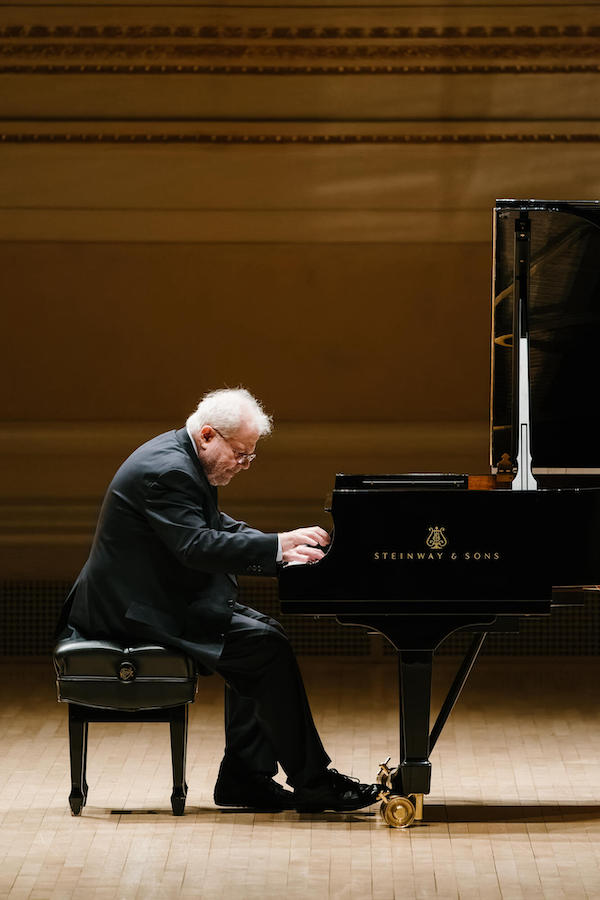The art that conceals art with Emanuel Ax, Schubert and Liszt at Carnegie Hall
“Flow” seems to be the word of the month right now. Economists, architects, and yoga instructors are all trying to help us get it.
Emanuel Ax has flow.
How else to describe the uncanny effect of his recital of piano works by Schubert, Liszt, and Schubert-Liszt at Carnegie Hall Thursday night? Playing two Schubert sonatas, Schubert songs arranged by Liszt, and the latter’s wide-canvas landscape “Vallée d’Obermann,” the veteran artist created the illusion of profound and affecting music unfolding of its own accord, while he merely supervised from the piano bench.
It’s not unusual to admire a pianist’s way of distinguishing one voice from another by weight or tone color, so that they work together contrapuntally. But it is something else to hear voices floating out so naturally and independently that one is tempted to look inside the instrument to see who’s hiding in there.
Nor is it rare to admire a pianist’s way with sudden transitions. It’s another to say “Of course, it jumps from B-flat major to C-sharp minor. How could it be otherwise?”
We don’t criticize musicians for shaking their locks and being “performative” (another vogue word); it is a performance, after all. But what to make of a pianist who creates divine sounds with the demeanor of a banker signing a loan application?
Best just to sit back and enjoy the stroll in an Alpine meadow that is Schubert’s Sonata in A major, D. 664. On Thursday, the walker hummed a carefree tune that was one of Schubert’s prettiest inspirations (which is saying something), with just enough agitated recollections to make that theme more welcome than ever when it returned. Unfortunately, Ax played it a little out of time, shortening the long notes, but for the most part his gently flexed tempo created an impression of relaxation and ease.
His timing was right on in the hypnotic Andante, with its short rhyming phrases and sketched accompaniment that unpretentiously led the listener into remote harmonic territory. After two concise movements, the closing rondo’s skipping main theme and playfully stormy episodes scrolled out to Schubertian “heavenly length,” circling back again and again for another look, buoyed along by an easy flow and a fresh take on each return.
In his own recitals, Franz Liszt served up a rich buffet of his own virtuoso or poetic compositions, hit tunes from the opera house, and music by then-underappreciated composers, of whom Schubert topped the list. On Thursday, Ax offered Liszt’s uncharacteristically modest takes on four Schubert songs, emphasizing their inner beauties while discreetly weaving “three hands” effects through the texture.
“Aufenthalt” (Resting Place) was a paradox of repose next to a roaring cataract, evoked in deep bass sonorities and a chromatic swirl, climaxing in a thick buildup of repeated chords. The flow was milder in “Liebesbotschaft” (Message of Love) but just as unceasing, as the singer sent a melodious greeting to his lover via a brook babbling in 32nd notes.
In “Der Müller und der Bach” (The Miller and the Brook), Ax proved a sensitive collaborator with himself, his right hand singing the miller’s yearning melody over a variety of characterful accompaniments. The element in “Horch, horch! die Lerch” (Hark, hark! the Lark) was not water but crystalline country air, evoked in the tinkling chords and filigree with which Schubert and Liszt decorated the bird’s dawn song.
It was back to the Alps, this time in a ruggedly Romantic landscape, with this program’s one Liszt original, “Valléed’Obermann” from the Swiss book of Années de pèlerinage (Years of Pilgrimage). Ax imagined the opening pages as a brooding pre-dawn scene, with no hint of the precipitous landscape out there in the gloom. Almost unnoticed, the trickle of a high, descending theme gathered resonance until it was a thunder of octaves and repeated chords, with the pianist regarding it all calmly, as if to say, “What could be more natural?”
The closing work, Schubert’s Sonata in B-flat major, D. 960, stood out not only for the pianist’s sense of flow but for the composer’s deliberate interruptions of that flow: the opening theme that paused in mid-phrase for an ominous trill deep in the bass, the lone octave that repeatedly stopped the finale in its tracks like a signal for attention. In a work composed just weeks before Schubert’s death, these enigmatic moments have been described as premonitions, or glimpses of the void. They never seemed more so than they did Thursday night.
The sonata’s soft but taut opening again sounded a little rushed, but it smoothed out in the more reflective exposition repeat and the even dreamier recapitulation much later. In this eventful movement, urgent forte jostled tender piano, sounding spontaneous yet part of a larger plan, in a Chopinesque way (Ax is a noted interpreter of his countryman’s music). The development was particularly adventurous, with episodes of storm, pathos, and distant thunder.
The pianist was a picture of concentration in the Andante sostenuto, softly laying out the parallel phrases on a very long line, brightening in the major-key middle section as repeated notes and arpeggios bubbled up, then dwindling to deep pianissimo for the exquisite final shift from minor to major. The playful Scherzo never stopped flowing, not for stormy episodes nor for the darker center section in the minor.
After that warning octave, the main theme of the finale searched anxiously for its home key, then passed through many variants in major and minor keys, now and then hitting that same octave stop sign. Despite all that, the music grew and developed organically in Ax’s hands, until a hot coda burst out, bringing this elusive sonata to a sudden yet exuberant end.
The single encore, Schubert’s “Ständchen” (Serenade) in Liszt’s delicate arrangement, displayed Ax’s delicious voicing: one stanza with just the amorous melody, the second as an echo duet, with the lover answering softly from her window.
Pianist Evgeny Kissin performs works by Bach, Mozart, Chopin and Rachmaninoff 8 p.m. Tuesday at Carnegie Hall. carnegiehall.org.


Posted May 05, 2023 at 9:52 am by Gordon Smith
We should not only take note of the lack of visual extravagance in a musical performance – we should celebrate it as an indication of the artist’s focus on the music. Great musicians of the past such as Heifetz and Horowitz were notable for their visual restraint and emphasis on concentration, sometimes to their detriment in cases where visual reserve was wrongly correlated to the absence of musical heat and shape. Heifetz and Horowitz brought it, and if Emanuel Ax did as well, we have that much more of a reason to shower him with appropriate compliments for devoting his energies to the music.
Even Wanda (Toscanini Horowitz) would listen to Vladimir from a location where she couldn’t see him, so that she could focus more completely on the musical performance. We should listen with our ears whenever possible.